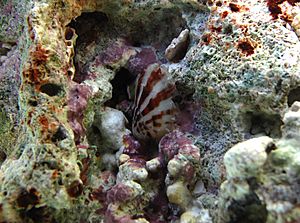Atlantic pearl-oyster facts for kids
Quick facts for kids Atlantic pearl-oyster |
|
|---|---|
 |
|
| Scientific classification | |
| Genus: |
Pinctada
|
| Species: |
radiata
|
| Synonyms | |
|
|
The Atlantic pearl-oyster, also called the Gulf pearl oyster, is a type of pearl oyster known as Pinctada radiata. These oysters live in many parts of the Indo-Pacific region. You can find them as far north as Japan and as far south as Victoria, Australia.
What Pinctada radiata Looks Like
P. radiata oysters are usually about 50 to 65 millimeters (2 to 2.5 inches) long. Some can grow larger, up to 106 millimeters (about 4 inches). Their shells are thin and somewhat flat, often looking square-shaped.
The outside of the shell has growth rings and ridges. It is usually brown or red, but can sometimes be green or bronze. The inside of the shell is shiny and pearly. Darker lines or rays might appear on the shell, especially near the edges.
These oysters can change their shape and look quite a bit. This is why they have had many different names over time. P. radiata is also a hermaphrodite, meaning each oyster has both male and female reproductive parts. How warm the water is affects when they are ready to reproduce.
Where Pinctada radiata Lives
Pinctada radiata lives all over the Indo-Pacific region and in the Mediterranean Sea. You can find them at many different depths, but they are most common between 5 and 25 meters (16 to 82 feet) deep.
These oysters attach themselves to hard surfaces like rocks or old shipwrecks. They are common in their habitats. This might be because they can live well in warm, subtropical waters. They can even survive in water that is a bit polluted.
Originally, these oysters only lived in the Indo-Pacific. But they were brought into the Mediterranean Sea in two ways. Some came by accident through the Suez Canal. Others were brought on purpose for aquaculture, which is like farming seafood.
How People Use Pinctada radiata
People collect Pinctada radiata mainly for their pearls. In places like Qatar, these oysters make up most of the pearl oyster catch. People also catch them for their meat, which can be eaten. Their beautiful, shiny shells are also used.
Scientists have also studied P. radiata for another important use. They can help us check for heavy metal pollution in the water. This is especially useful in places like the Persian Gulf.

